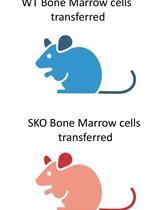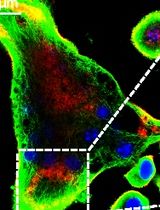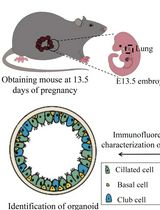- EN - English
- CN - 中文
Visualization of RNA at the Single Cell Level by Fluorescent in situ Hybridization Coupled to Flow Cytometry
采用荧光原位杂交结合流式细胞术在单细胞水平上观察RNA
发布: 2018年06月20日第8卷第12期 DOI: 10.21769/BioProtoc.2892 浏览次数: 6923
评审: Ivan ZanoniShanie Saghafian-HedengrenAnonymous reviewer(s)
Abstract
The protocol described here has been developed to detect RNA at the single cell level. Fluorescent probes hybridize to target RNAs and are detected by flow cytometry after multiple amplification steps. Different types of RNA can be detected such as mRNA, long noncoding RNA, viral RNA or telomere RNA and up to 4 different target probes can be used simultaneously. We used this protocol to specifically measure the expression of two transcription factor mRNAs, MAFB and IRF4, in human monocytes.
Keywords: RNA (RNA)Background
RT-qPCR is one major technique used to easily assess RNA expression. Cells are lysed and analyzed in bulk. Hence, cell heterogeneity is lost. In particular, it is impossible using RT-qPCR to address whether subpopulations may be identified based on the expression of RNA. RNA Fluorescent In Situ Hybridization (FISH) is a way to detect RNA in single cells. This technique requires hybridization of fluorescent probes on RNA targets that are then detected using an imaging system such as a confocal microscope. However, this method is time-consuming and allows the analysis of a limited number of individual cells.
We demonstrated by RT-qPCR that human monocytes cultured in RPMI with M-CSF, IL-4, and TNFa express after three hours the transcription factors MAFB and IRF4 (Goudot et al., 2017). MAFB and IRF4 are involved in the differentiation of monocytes into monocyte-derived macrophages (mo-mac) and monocyte-derived DC (mo-DC) respectively. To decipher whether monocytes express both transcription factors or if this expression is mutually exclusive, we performed in situ hybridization coupled to flow cytometry using PrimeFlow RNA assay.
Materials and Reagents
- P1000, P200, P20 pipettes tips (any supplier)
- 15 and 50 ml conical tubes (any supplier)
- PrimeFlow RNA tubes (Thermo Fisher Scientific, catalog number: 19197 )
- PrimeFlow® RNA 96-well plate (Thermo Fisher Scientific, catalog number: 44-17005 )
- PrimeFlow® RNA Wash Buffer (Thermo Fisher Scientific, catalog number: 00-19180 )
- Fixable Viability Dye eFluorTM 506 (Thermo Fisher Scientific, eBioscienceTM, catalog number: 65-0866-14 )
- PrimeFlow® RNA Fixation Buffer 1A (Thermo Fisher Scientific, catalog number: 00-18100 )
- PrimeFlow® RNA Fixation Buffer 1B (Thermo Fisher Scientific, catalog number: 00-18200 )
- PrimeFlow® RNA Fixation Buffer 2 (8x) (Thermo Fisher Scientific, catalog number: 00-18400 )
- PrimeFlow® RNA Permeabilization Buffer (10x) (Thermo Fisher Scientific, catalog number: 00-18300 )
- PrimeFlow® RNase Inhibitors (100x) (Thermo Fisher Scientific, catalog number: 00-16002 )
- PrimeFlow® RNA Target Probe Diluent (Thermo Fisher Scientific, catalog number: 00-19185 )
- PrimeFlow® RNA Label Probe Diluent (Thermo Fisher Scientific, catalog number: 00-19183 )
- PrimeFlow® Compensation kit (Thermo Fisher Scientific, catalog number: 88-17001 )
- PrimeFlow® RNA Storage Buffer (Thermo Fisher Scientific, catalog number: 00-19178 )
- AlexaFluor 647 IRF4 (Thermo Fisher Scientific, PF-204, assay ID: VA1-13919-PF) and AlexaFluor 488 MAFB (Thermo Fisher Scientific, PF-204, assay ID: VA4-16783-PF) probe sets
- PBS (Eurobio, catalog reference: CS1PBS01-01 )
- EDTA (Thermo Fisher Scientific, InvitrogenTM, catalog number: 15575020 )
- Human serum (BioWest, catalog number: S4190-190 )
- RPMI-Glutamax medium (Thermo Fisher Scientific, GibcoTM, catalog number: 61870010 )
- Penicillin and streptomycin (Thermo Fisher Scientific, GibcoTM, catalog number: 15140122 )
- Fetal calf serum (Biosera, catalog number: FB-1001 )
- M-CSF (Miltenyi Biotec, catalog number: 130-096-492 )
- IL-4 (Miltenyi Biotec, catalog number: 130-093-922 )
- TNFa (Miltenyi Biotec, catalog number: 130-094-014 )
- FICZ (Enzo Life Sciences, catalog number: BML-GR206-0100 )
- Flow cytometry buffer (see Recipes)
- Culture medium for monocyte differentiation (see Recipes)
Equipment
- P1000, P200, P20 pipettes
- Incubator
- Fridge
- Freezer
- Metal heat block (if 1.5 ml tubes are used)
- Refrigerated centrifuge for Eppendorf tubes (Eppendorf, model: 5424R ) or plates (Eppendorf, model: 5810R )
- Flow cytometer with 3 lasers (488 nm, 561 nm, 633 nm)
Software
- FlowJo V10 (Tree Star)
Procedure
文章信息
版权信息
© 2018 The Authors; exclusive licensee Bio-protocol LLC.
如何引用
Coillard, A. and Segura, E. (2018). Visualization of RNA at the Single Cell Level by Fluorescent in situ Hybridization Coupled to Flow Cytometry. Bio-protocol 8(12): e2892. DOI: 10.21769/BioProtoc.2892.
分类
免疫学 > 免疫细胞染色 > 流式细胞术
发育生物学 > 细胞生长和命运决定 > 分化
细胞生物学 > 细胞染色 > 核酸
您对这篇实验方法有问题吗?
在此处发布您的问题,我们将邀请本文作者来回答。同时,我们会将您的问题发布到Bio-protocol Exchange,以便寻求社区成员的帮助。
提问指南
+ 问题描述
写下详细的问题描述,包括所有有助于他人回答您问题的信息(例如实验过程、条件和相关图像等)。
Share
Bluesky
X
Copy link












